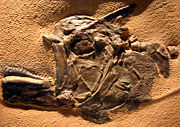
Ichthyodectes
Encyclopedia
Ichthyodectes ctenodon ("Fish Biter (with) Comb Teeth") was a 4-metre long ichthyodectid. It lived in the Western Interior Seaway
during the late Cretaceous
. It was closely related to the 4 to 6 metre long Xiphactinus
audax, and the 2-metre long Gillicus arcuatus
, and like other ichthyodectids, I. ctenodon is presumed to have been a swift predator of smaller fish. As its species name suggests, I. ctenodon had small, uniformly sized teeth, as did its smaller relative, G. arcuatus, and may have simply sucked suitably sized prey into its mouth.

Western Interior Seaway
The Western Interior Seaway, also called the Cretaceous Seaway, the Niobraran Sea, and the North American Inland Sea, was a huge inland sea that split the continent of North America into two halves, Laramidia and Appalachia, during most of the mid- and late-Cretaceous Period...
during the late Cretaceous
Cretaceous
The Cretaceous , derived from the Latin "creta" , usually abbreviated K for its German translation Kreide , is a geologic period and system from circa to million years ago. In the geologic timescale, the Cretaceous follows the Jurassic period and is followed by the Paleogene period of the...
. It was closely related to the 4 to 6 metre long Xiphactinus
Xiphactinus
Xiphactinus was a large, 4.5 to 6 m long predatory bony fish that lived in the Western Interior Sea, over what is now the middle of North America, during the Late Cretaceous. When alive, the fish would have resembled a gargantuan, fanged tarpon...
audax, and the 2-metre long Gillicus arcuatus
Gillicus arcuatus
Gillicus arcuatus was a relatively small, 2-metre long ichthyodectid fish that lived in the Western Interior Seaway, in what is now central North America, during the Late Cretaceous. Like its larger relative, Ichthyodectes ctenodon, G...
, and like other ichthyodectids, I. ctenodon is presumed to have been a swift predator of smaller fish. As its species name suggests, I. ctenodon had small, uniformly sized teeth, as did its smaller relative, G. arcuatus, and may have simply sucked suitably sized prey into its mouth.


